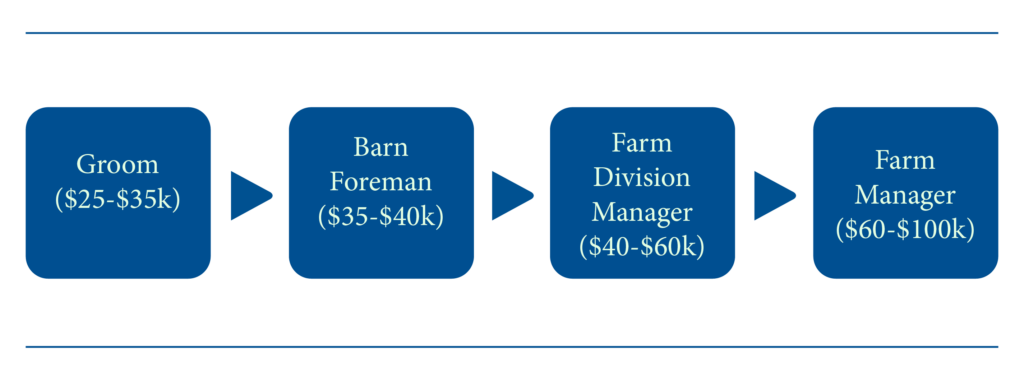Our employers had to change their perspective, said Laurie Mays, Kentucky Chamber Foundation project manager, agriculture and equine talent pipeline. You are not hiring an entry-level person. You are hiring a future farm manager. How do you see that person through their career path? That has given a lot of ownership to those employees to see what their career might look like in ten years. Now they stick around, knowing that they are not going to get stuck in an entry-level position.
The Gross Regional Product of Kentucky’s Agriculture Sector
The Challenge
Agriculture remains a major sector in Kentucky’s economy but faces critical labor challenges. Like many industries across the country, Kentucky horse farms recently experienced high turnover among entry-level employees, causing increased costs and workplace disruptions. Not only were employees leaving their jobs, but they were leaving horse farms and the agriculture sector entirely. This created a critical threat to the long-term sustainability of a vital part of Kentucky’s economy. Employers needed to solve the root problems of why employees quit while maintaining the viability of their businesses.
The Solution
Building on earlier collaboration with the U.S. Chamber Foundation’s Talent Pipeline Management® (TPM) program, the Kentucky Chamber Foundation launched an initiative to help a broad range of industries, including agriculture and horse farms. Led by Laurie Mays, the agriculture program worked collaboratively with farms and employees to identify the root causes of turnover and create a strategy to improve job quality.
Mays used the TPM framework to engage with employees, learn about their concerns, and craft solutions with employers. This led to increased leadership and management training, clearer career pathways with more support for employees, and adjusted operations to improve working conditions. As a result, employers reduced turnover, employees became more invested in their careers, and both groups developed strategies to work better together. By giving greater voice to employees, Kentucky’s horse farms increased the average length of employment for entry-level positions from around 10 months to 18–24 months.

An Employee Retention Crisis Highlights
Job Quality Issues
While employers had countless previous conversations with employees about why they were leaving, Mays and the Kentucky Chamber Foundation added value by introducing more robust feedback processes. First, the Kentucky Chamber Foundation sent out a survey, which identified key initial issues. Whereas the traditional approach of TPM has offered a process for creating employer collaboratives, the Kentucky Chamber Foundation launched an employee collaborative in parallel to the employer group, which allowed for ongoing problem-solving for employees to address areas where their jobs could be improved upon. Mays is continuing to leverage these feedback mechanisms for horse farms, while also applying them to other agricultural industries.
The surveys highlighted major issues around the relationship between employees and their direct supervisors. Anne McKay, Director of Human Resources at Taylor Made Farm, noted that, “We often elevated people based on their horsemanship skills, not necessarily their management skills, and we didn’t provide a lot of management training.” In turn, many managers struggled to support their teams and entry-level staff did not enjoy dealing with their supervisors, leading to turnover issues.
While surveys allowed for one-time feedback, the employee collaborative allowed ongoing feedback and collaboration. Employee representatives met with Mays at breweries and other informal locations to discuss issues. Rather than representing their farms and focusing on individual grievances, they represented workers across all the farms—for example, as “the voice of” thoroughbred grooms, barn crew, or mechanics. Mays then anonymized and summarized the feedback before taking it to employers, which had committed to take action and validate the input from their employees.

Treating Entry-Level Employees Like Future Managers
Those actions began with supervisor training. Based on the surveys and employee collaborative feedback, Mays and the farms developed customized training that targeted the specific issues identified by employees. They also shared lessons learned across farms, many of which had small human resource teams, if any. Sharing promising practices solved an immediate need, while also facilitating more learning and conversations about other issues.
Key among those issues was entry-level employees feeling “stuck” in $15 per hour jobs. The supervisor training identified that both supervisors and their teams needed resources to help support career pathways. To solve this problem, Mays worked with farms to develop clear career pathways into various aspects of the industry, showing pay increases, experience required, and other key information.
As conversations with the employee collaborative progressed, employees and employers worked together on other solutions to improve job quality while maintaining operations and profitability. One example was figuring out how to shift from a 6-day workweek to a 5-day workweek. While it called for a change in operations, it reduced turnover sufficiently to justify the change.

Success Yields Improvement and Savings
Along the way, employers achieved significant savings and operational efficiency by increasing average length of employment. Employees also experienced increased happiness in their roles and career trajectories, as well as an increase in internal promotions of entry-level staff. After some employers previously failed to solve retention issues by increasing pay by up to $2 per hour, these changes finally provided solutions to their problems. They learned that there are many elements to job quality that affect whether an employee stays or quits. To diagnose and solve the root issues, employers needed Mays, the Kentucky Chamber Foundation, and the TPM framework to provide the necessary feedback and make real change.
